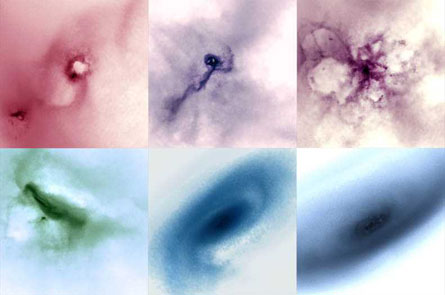View video of a simulation of dwarf galaxy formation.

After years of struggling to understand how to properly assemble a galaxy, astronomers have discovered that the answer is blowin’ in the wind. The supernova wind, that is.
New computer simulations show that winds generated by supernovas, which are the explosions of massive stars, can push stars out from the center of a dwarf galaxy. This simulation of supernova winds redistributes both ordinary matter and invisible dark matter in a way that almost perfectly matches observations of the way matter is distributed in actual dwarf galaxies. Fabio Governato of the University of Washington in Seattle and his colleagues describe their simulations in the Jan. 14 Nature.
Previous attempts to model galaxy formation based on the highly successful theory of cold dark matter — which states that invisible material must account for 85 percent of the mass of the universe — have done “an awesome job” of explaining such global properties as where, when and how many galaxies should form, notes Governato. But the models have failed to reproduce some of the key features of individual galaxies.
In particular, those simulations have produced galaxies whose centers are stuffed with too much dark matter and that are surrounded by a spherical distribution of stars that actual dwarf galaxies don’t possess. Dwarf galaxies, which are low-mass bodies with relatively uniform distributions of stars, are the most common type of galaxy in the neighborhood of the Milky Way.
Most of these earlier models included either a simplistic description of star formation or neglected star formation altogether. “Our simulations achieve the necessary resolution to follow the formation of individual star forming regions — dense clouds of gas containing the equivalent of 100,000 suns,” says Governato. Star formation is concentrated in the center of a galaxy, and because massive stars live for only a short time, they go supernova in the same region where they were born. As a result, supernova winds are also concentrated in galaxy centers.
Governato’s team showed that the supernova winds are intense enough to push both stars and star-forming clouds out of a dwarf galaxy’s core. Dark matter responds to gravity but is impervious to the winds. As the stars exit the core, the dark matter there feels a smaller gravitational tug and expands outward.
In one fell swoop, the model’s successful simulation of supernova winds not only reduces the density of the dark matter at the core but also does away with the spherical distribution of stars around the core, matching the properties of actual dwarf galaxies, Governato says.
Other studies have shown that supernova winds influenced the assembly of faraway dwarf galaxies that hark from the early universe, which had a chemical composition much simpler than today’s, notes Till Sawala of the Max Planck Institute for Astrophysics in Garching, Germany. But the new simulations are the first to successfully apply supernova winds to the formation of nearby dwarfs, Sawala adds.
Successful simulations of supernova winds can help in understanding star formation because supernovas explode close to where massive stars are born. At the same time, Simon White, director of the institute, notes that it’s unclear exactly how the particular star-forming recipe used by Governato and his colleagues differs from those of other teams and why it’s achieved such a good match with observations.
In another study, which is in press for the Monthly Notices of the Royal Astronomical Society, Sawala, White and their colleagues examine the effect of supernova winds in dwarf galaxies that are much smaller than those modeled by Governato and his colleagues. The researchers show that supernova winds in those “ultra-dwarf” galaxies hamper star formation so much that the tiny galaxies are barely visible. The finding could explain another long-standing discrepancy: Dark matter theory predicts a much higher abundance of tiny satellite galaxies around the Milky Way than has been observed. Perhaps the galaxies are really there but have too few stars to be detected.
The simulated dwarf from Science News on Vimeo.
This supercomputer simulation relies on a refined understanding of dark matter and star formation to reproduce observed features of a dwarf galaxy.
Credit: Governato et al.







